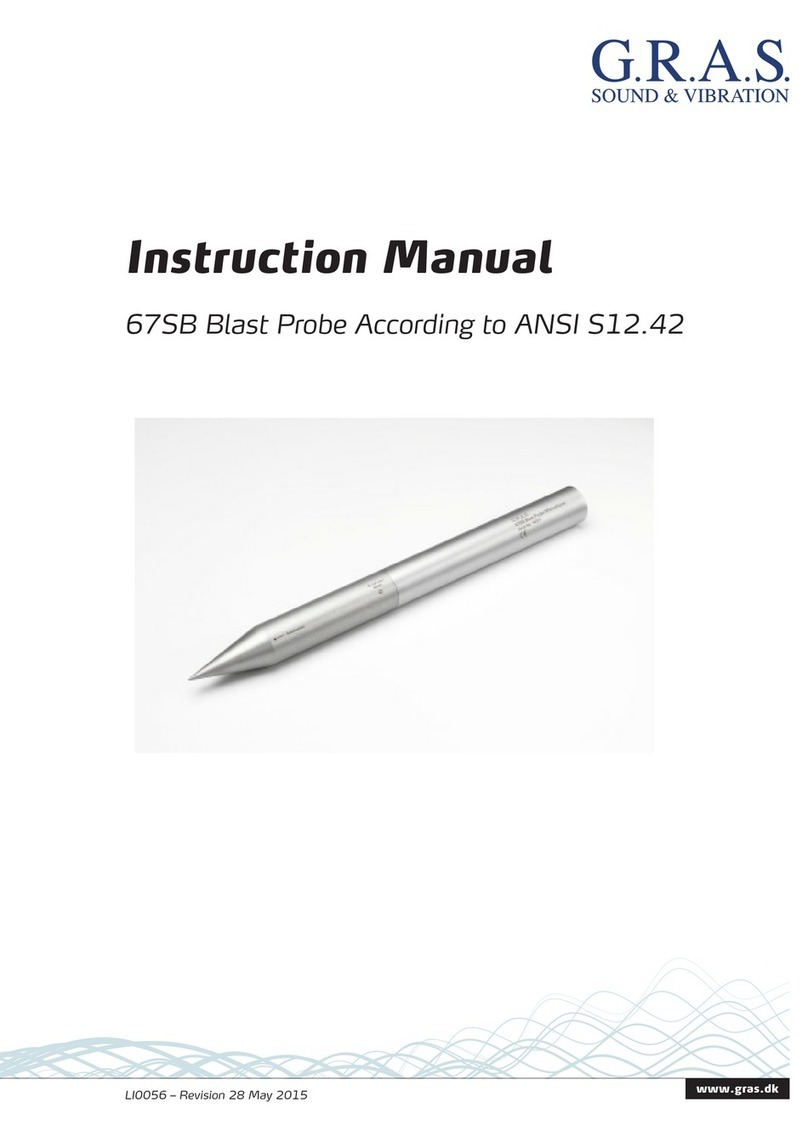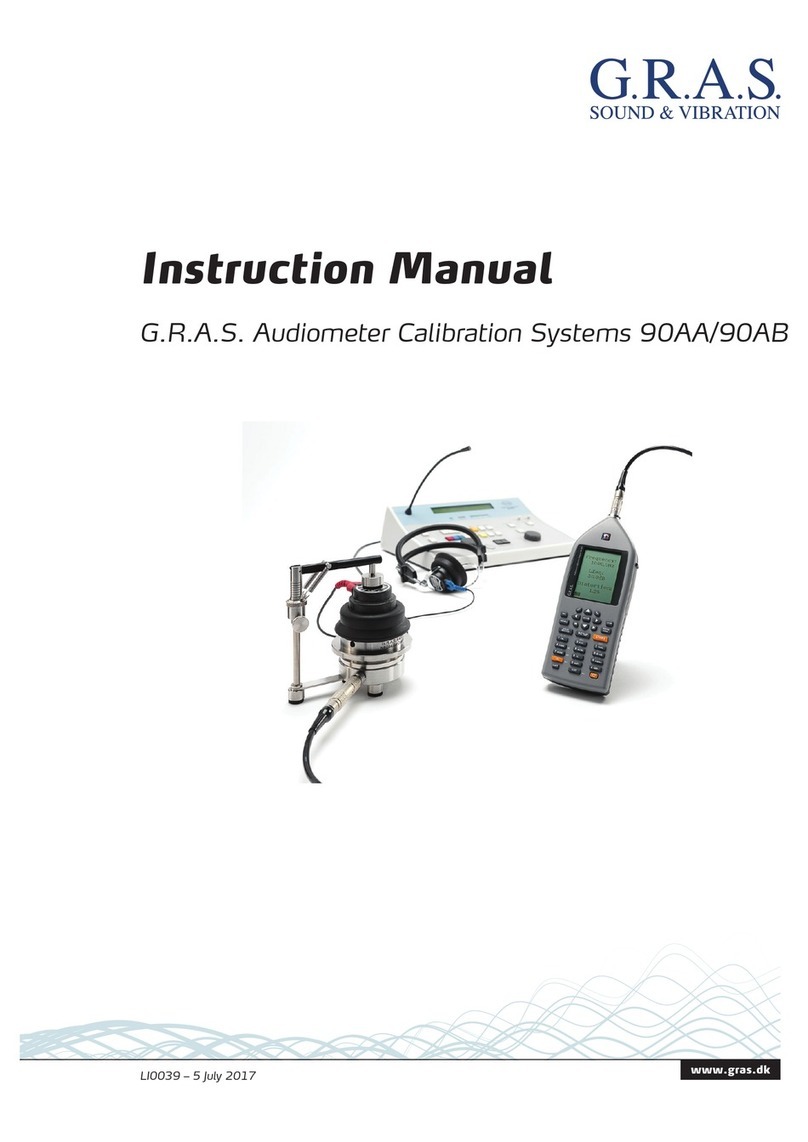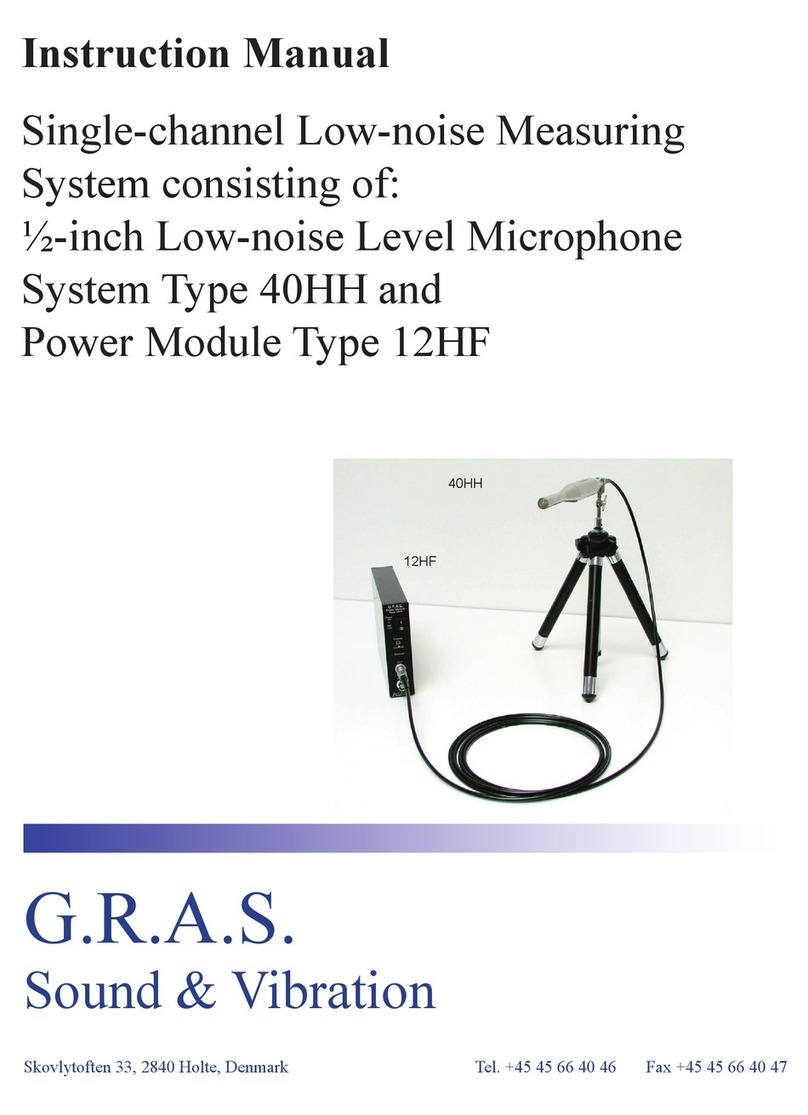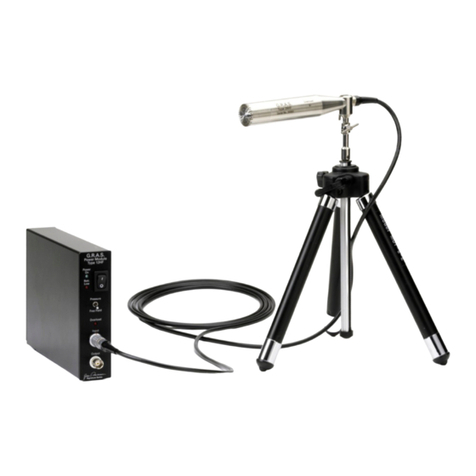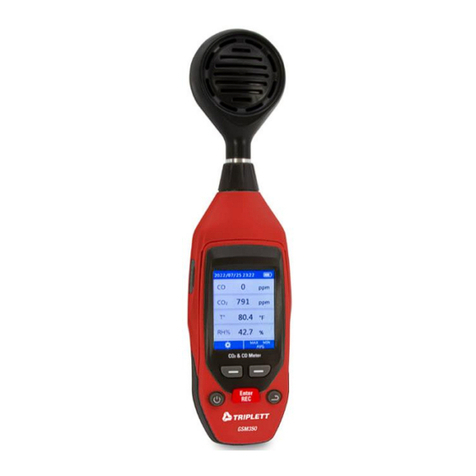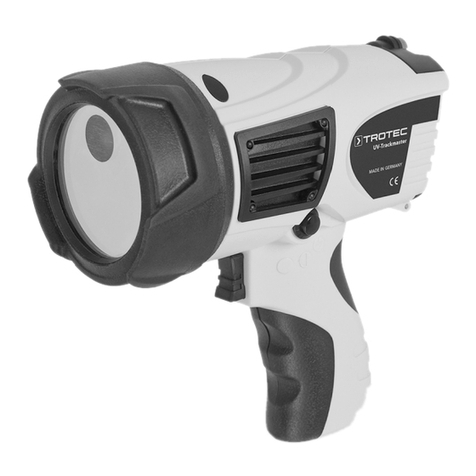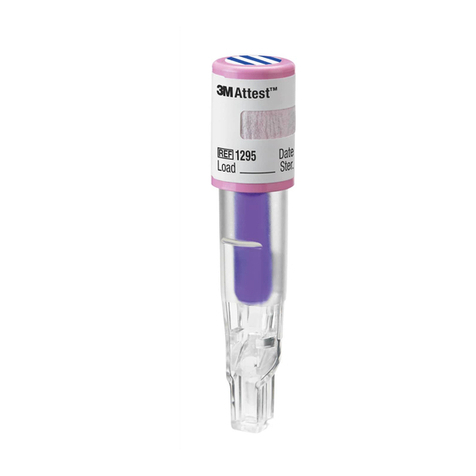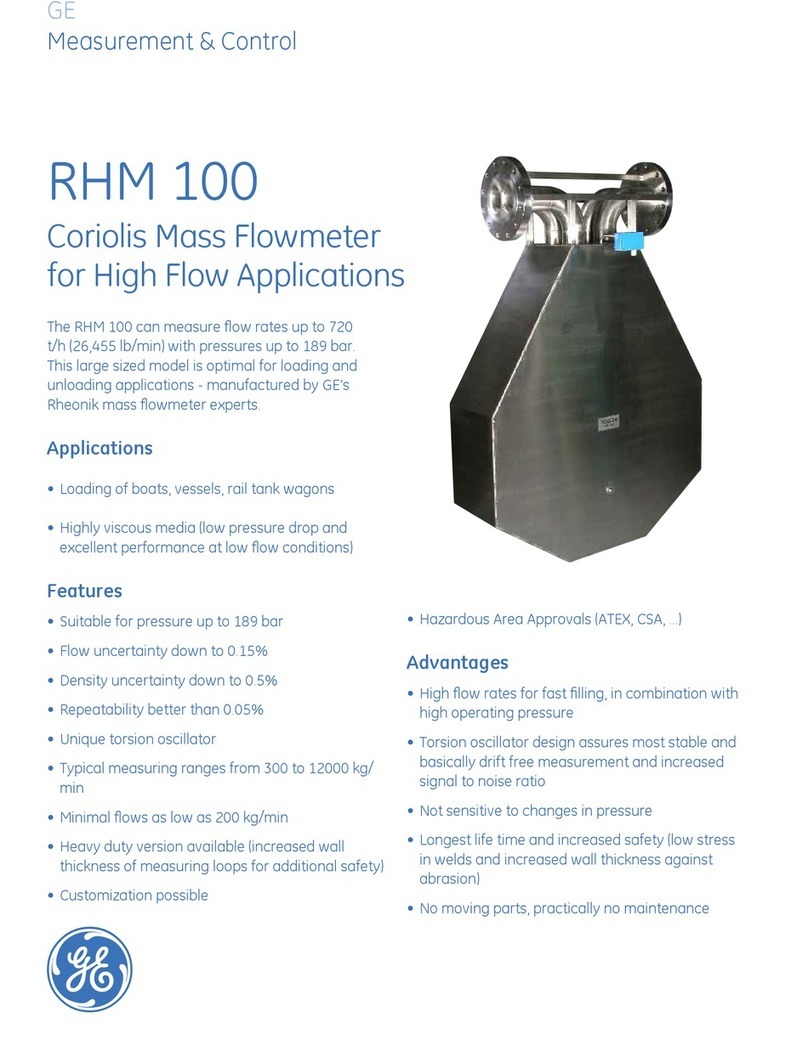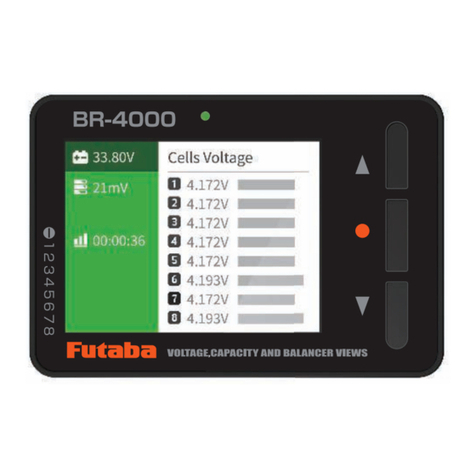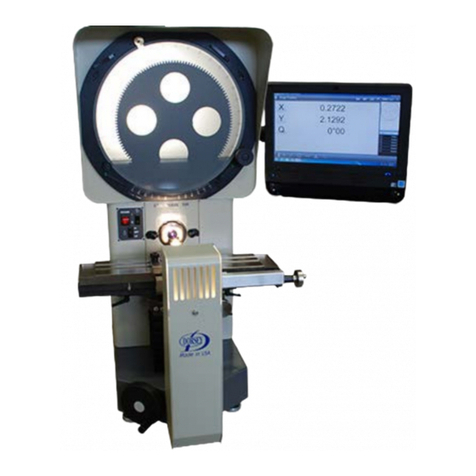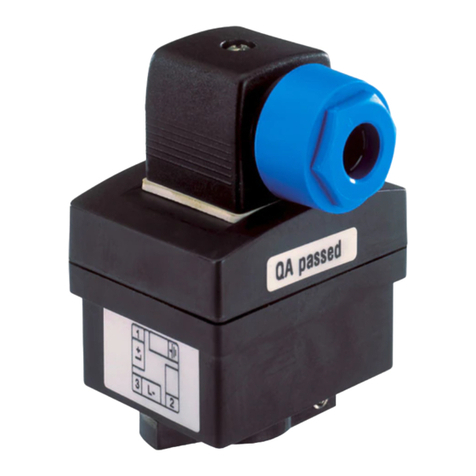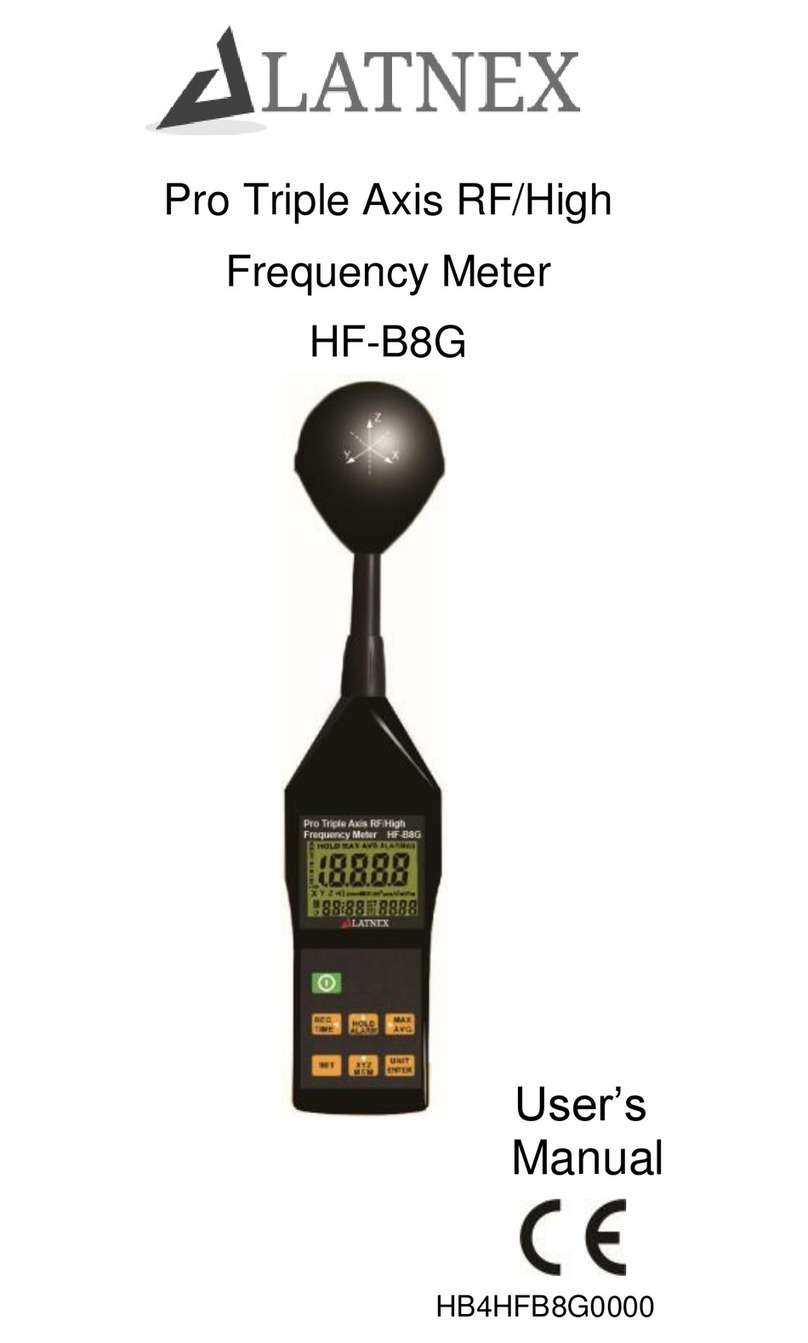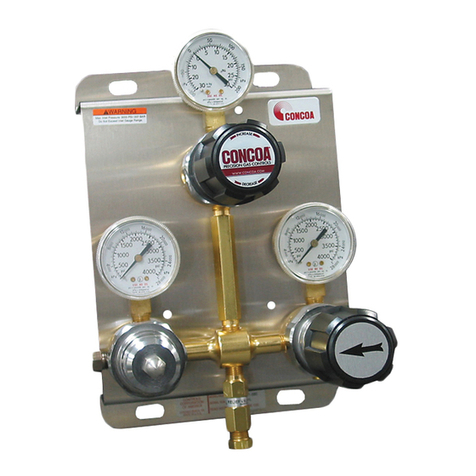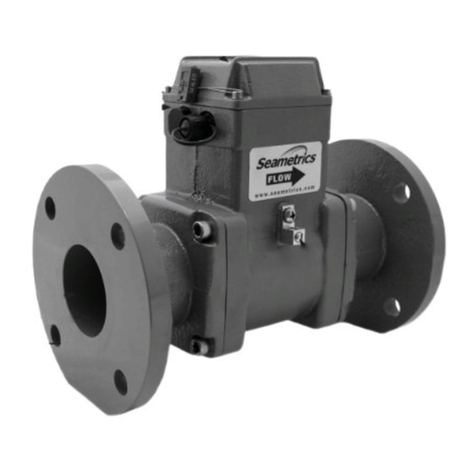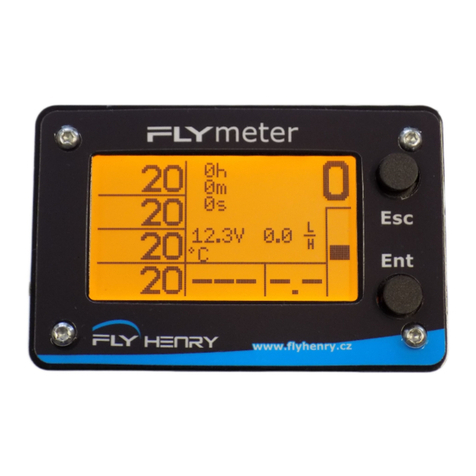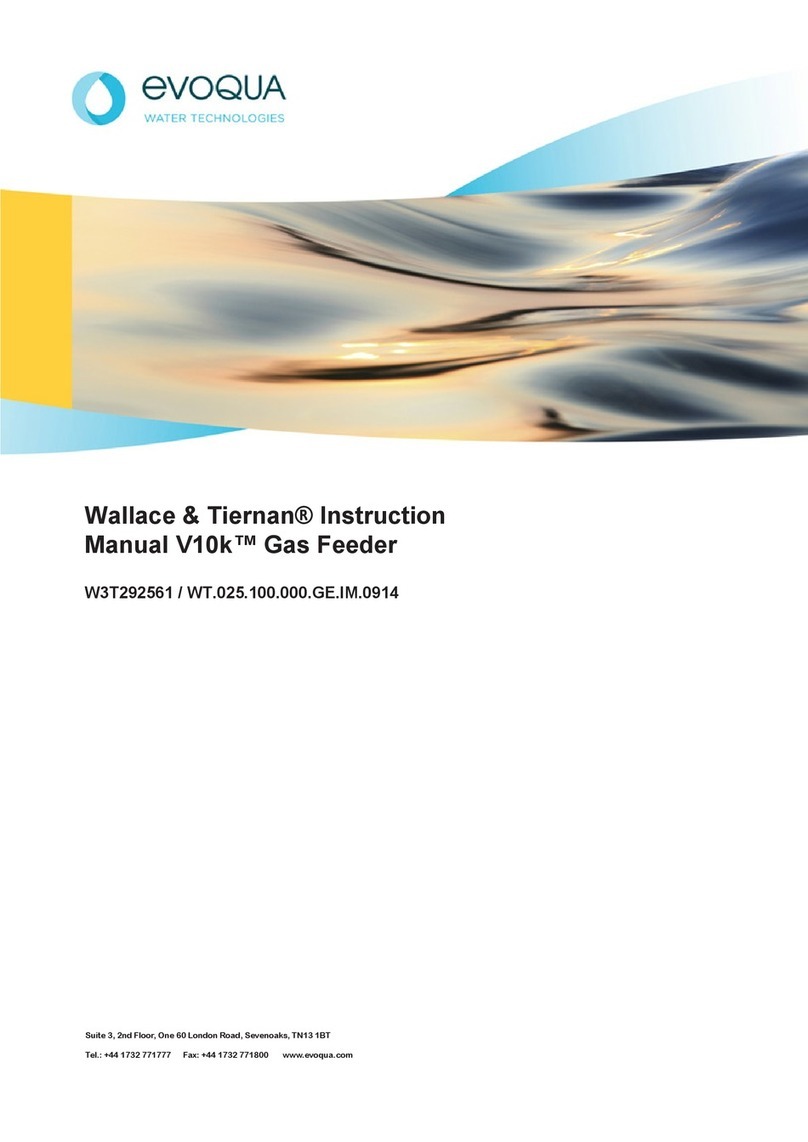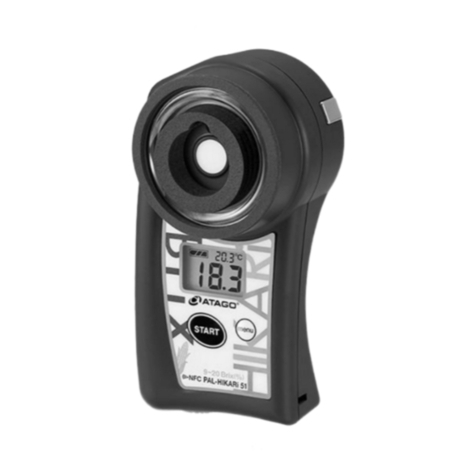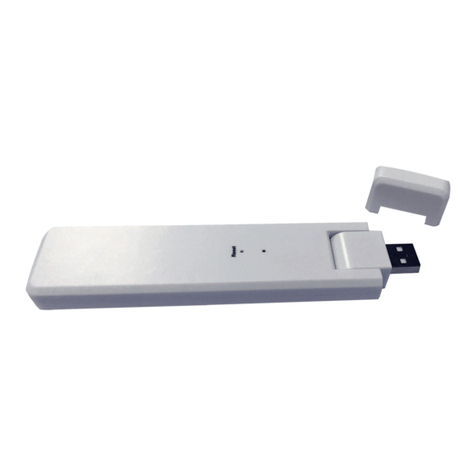G.R.A.S. 50AI User manual

Instruction Manual
Sound Intensity Probe Type 50AI
G.R.A.S.
Sound & Vibration
Skovlytoften 33, 2840 Holte, Denmark www.gras.dk

Revision 6 June.2014
Sound-intensity Probe Type 50AI

G.R.A.S. Sound & Vibration
CONTENTS
1. Introduction and Description. . . . . . . . . . . . . . . . . . . . . . . . . . . . . . . . . . . . . . . 3
1.1 Main Components..................................................4
Microphones .............................................................4
Preampliers . . . . . . . . . . . . . . . . . . . . . . . . . . . . . . . . . . . . . . . . . . . . . . . . . . . . . . . . . . . . . 5
1.2 Available Versions..................................................6
2. Input Channels ..................................................9
2.1 PreamplierInputsAandB. . . . . . . . . . . . . . . . . . . . . . . . . . . . . . . . . . . . . . . . . . . 9
2.2 Sound-intensityAxis ................................................9
3. Output Socket . . . . . . . . . . . . . . . . . . . . . . . . . . . . . . . . . . . . . . . . . . . . . . . . . . 11
3.1 UsewithPowerModuleType12AB ...................................11
4. Handling and Assembling the Probe ...............................12
4.1 TheMicrophones .................................................12
4.2 Probe Design ....................................................12
4.3 PhysicalStrength .................................................12
4.4 Assembling the Probe. . . . . . . . . . . . . . . . . . . . . . . . . . . . . . . . . . . . . . . . . . . . . . 12
4.5 UsingtheWindscreen. . . . . . . . . . . . . . . . . . . . . . . . . . . . . . . . . . . . . . . . . . . . . . 14
5. Specications ..................................................16
5.1 All versions:. . . . . . . . . . . . . . . . . . . . . . . . . . . . . . . . . . . . . . . . . . . . . . . . . . . . . . 16
5.2 VersionB. . . . . . . . . . . . . . . . . . . . . . . . . . . . . . . . . . . . . . . . . . . . . . . . . . . . . . . . 16
5.3 Version C .......................................................16
5.4 Version D .......................................................17
5.5 Version HP ......................................................17
5.6 Version LD ......................................................17

G.R.A.S. Sound & Vibration
Sound-intensity Probe Type 50AI - Page 4
1. Introduction and Description
TheSound-intensityProbeType50AI(Fig.1.1)isatwo-microphonesoundintensityprobe.It
hasapairofG.R.A.S.phase-matched½″microphonesType40AI(Fig.1.2),twoG.R.A.S.¼″
microphonepreampliersType26AA,solidspacers,remotecontrolhandleandconnection
cable.Theprobeisadjustable,durableandfullycomplieswiththefollowingrequirements:
• IEC61043,Electroacoustics-InstrumentsfortheMeasurementofSoundIntensity-Meas-
urementswithPairsofPressureSensingMicrophones,1993forClass1Sound-intensity
probes.
Fig. 1.1 The Sound-intensity Probe Type 50AI

G.R.A.S. Sound & Vibration
Sound-intensity Probe Type 50AI - Page 5
Fig. 1.2 The type of carrying case delivered with the Type 50AI
1.1 Main Components
ThemaincomponentsoftheSound-intensityProbeType50AIare:
• SoundIntensityMicrophonePairType40AK
• TwoMicrophonePreampliersType26AA
• Foursolidspacersofvariouslengthsandaspacercup(seeFig.1.5)
• Remote-controlhandlewith(whereapplicable)uptotwopushbuttonsforcontrollingmeas-
urements
SeealsoFig.1.8.
TheType50AIisdeliveredinacarryingcasesimilartotheoneshowninFig.1.2,completewith
microphones,preampliers,standardaccessoriesandaremote-controlhandle.
1.1.1 Microphones
Themicrophones(Fig.1.3)arehighsensitivity,free-eld½″condensermicrophoneswitha
uniquely-designedpressureequalizationsystemthatensuresextremelywelldenedphase
characteristics.Themicrophonesandpreampliersaremountedontheendofthetelescopic
armoftheRemote-controlhandle.Tocoverthefullfrequencyrangefrom50Hzto10kHz,the
Type50AIisdeliveredwithfoursolidinterchangeablespacersforspacingthemicrophonesat
12mm,25mm,50mmand100mm.

G.R.A.S. Sound & Vibration
Sound-intensity Probe Type 50AI - Page 6
1.1.2 Preampliers
Thesmall¼″diameterand40mmlongmicrophonepreampliers(Fig.1.4)arehousedin
robust,stainlesssteelcasingswhichenablenovelprobedesignsthatreducedisturbancesto
thesoundeldotherwisebroughtaboutbytheeffectsofshadowsanddiffraction.Symmetryof
designenablesreliablecalibrationsasdescribedintheproposedstandard(ISO/DIS9614-2)for
soundpowermeasurementsusingsound-intensitymeasurements.
Fig. 1.3 Showing similar pairs of phase-matched ½″ microphone cartridges
Above: Type 40AK, which includes spacers and three adapters for
¼″ preampliers as supplied with the Type 50AI.
Below: Type 40AI, which includes cartridges only
Fig. 1.4 Pair of ¼″ Preampliers Type 26AA supplied with the Type 50AI
Fig. 1.5 Showing the various spacers and the spacer cup supplied with the Type 50AI
RA0263
100 mm spacer
RA0264
50 mm spacer
RA0265
25 mm spacer
RA0266
12 mm spacer
GR0040
Spacer cup

G.R.A.S. Sound & Vibration
Sound-intensity Probe Type 50AI - Page 7
Fig. 1.6 Showing the markings and external features on the remote-control handles of the various
versions of the Type 50AI
1.2 Available Versions
VariousversionsoftheType50AIareavailablefordirectusewithawiderangeofgeneral-pur-
posefrequencyanalysersaswellasspecialisedsoundintensityanalysers.Fig.1.6showsthe
mainexternalfeaturesofthevariousversions.
Type 50AI version B
Hasbuilt-inremote-controlfunctionsfordirectconnectionto,andcontrolof,sound-intensity
measuringsystemsfromawiderangeofsupplierssuchas01dB,Müller-BBMandNeutrix-
Cortex.
CanbeuseddirectlywiththeG.R.A.S.IntensityModuleType12AB(seealsosection3.1),
whichprovidesallnecessaryvoltagesfortheremote-controlfunctionsandpoweringthepream-
pliers.
TheIntensityModuleType12AB(whichisbattery-operated)hastwostandardBNCoutput
socketsforconnectingtoanalysersthatdon’thavespecialmicrophone-preamplierinputsand
a9-pinD-subsocketwiredupforconnectingdirectlytotheRS232portofacomputer(Fig.3.2);
thusenablingsoftwaretobecontrolledbytheremotecontrolfacilitiesofthisversionofthe
Sound-intensityProbe.
UsewiththeType12ABenablesdirectusewith01dBSoundIntensitysystems.
Type50AI
version HP
Type50AI
version C
Type50AI
versionB
version D
version LD

G.R.A.S. Sound & Vibration
Sound-intensity Probe Type 50AI - Page 8
Type 50AI version C
Canbeconnecteddirectlytoanyanalyserwithtwostandard7-pinLEMOmicrophone-preampli-
erinputs.
CanbeusedwiththefollowingG.R.A.S.PowerModules,whichprovideallnecessaryvoltages
forpoweringthepreampliers:
• IntensityModuleType12AB(seedescriptionaboveunderversionB)
• PowerModuleType12AA
(viatheincludedadaptercableAC0003,whichsplitstheoutputfroma12-pinLEMOsocket
intotwo7-pinLEMOplugs)
ThePowerModuleType12AA(whichisbattery-operated)hastwostandardBNCoutputsock-
etsforconnectingtoanalysersthatdon’thavespecialmicrophone-preamplierinputs.
Type 50AI version D
SimilartoversionBbutusesaninternal9-Vbattery(alreadyttedondelivery)forenablingits
remote-controlfunctions.Fig1.7showshowtogainaccesstothebattery.
Type 50AI version HP
Hasbuilt-inremote-controlfunctionsfordirectconnectionto,andcontrolof,Hewlett-Packard
analyserssuchasthetypesHP3569AandHP35670AOptUK4.
BothoftheseanalyserswillsupporttheLEDsmarkedOVERLOADandMEASURING as well as
thecontrolbuttonmarkedSTART/GATE.
Type 50AI version LD
Hasbuilt-inremotecontrolfunctionsfordirectuseandcontrolofLarsonDavisanalyserssuch
asthetypesLD2900andLD3000.
Fig. 1.7 Access to the 9 -V battery located inside the remote-control handle of the
Type 50AI version D. The battery should be disconnected / reconnected
while inside the remote-control handle
Unscrewand
remove
Slidecover
back

G.R.A.S. Sound & Vibration
Sound-intensity Probe Type 50AI - Page 9
Fig. 1.8 Showing the main components of the Sound-intensity Probe Type 50AI prior to assembly
RA0263
100 mm spacer
RA0264
50 mm spacer
RA0265
25 mm spacer
RA0266
12 mm spacer
GR0040
Spacer cup
RA0003
Straightadapter
PairofType26AA
¼″preampliers
Type40AI
Pairofphase-matched½″microphones
Pair of RA0001
Right-angledadapters
OutputsocketRemote-controlbuttonsTelescopicarmPreamplierinputsSwivelhead

G.R.A.S. Sound & Vibration
Sound-intensity Probe Type 50AI - Page 10
2. Input Channels
TheType50AIhastwoinputchannels,one
foreachmicrophonepreamplier.Thechan-
nelsaremarkedAandBontheremote-control
handle,seeFig.2.1.
2.1 PreamplierInputsAandB
AandBrefertothetwochannelsoftheprobe.
ChannelAisreservedfortheleadingmicro-
phone,i.e.themicrophonerststruckbyan
acousticwavefront(seeFig.2.2).Whenthis
happens,thisshouldbeinterpretedasaposi-
tivecomponentofthesoundintensityinthe
directionfrommicrophoneAtomicrophoneB.
2.2 Sound-intensity Axis
Fig.2.2illustratestheoriginanddirectionof
positivesound-intensityvectors.Thispositive
directionisalwaysfrommicrophonesAtoB.
Theoriginofthesound-intensityaxisliesonthe
geometric centre of the pair of probe micro-
phones.
Fig. 2.1 Showing the inputs and markings for
the two preamplier inputs
InputforchannelB
InputforchannelA
Markingsforchan-
nelsAandB

G.R.A.S. Sound & Vibration
Sound-intensity Probe Type 50AI - Page 11
Fig. 2.2 Showing the microphones ‘A’ and ‘B’ which correspond with channels
A and B respectively. ‘A’ is the leading microphone and is struck rst by a
sound wave
AB
+
Direction
of positive
intensity
Type40AKpair
Originofintensityaxis
A
leadingmic.
B
trailing mic.

G.R.A.S. Sound & Vibration
Sound-intensity Probe Type 50AI - Page 12
3. Output Socket
ThepinconnectionsoftheLEMOoutputsocketatthebaseoftheType50AIareshownin
Fig.3.1.Thefourinnerpins,i.e.9,10,11and12areforenablingadialoguebetweenauser
andananalyser/computerviaanRS232port.Theyareusedto:
a)Transmitthestate(pressed/notpressed)ofthetwopushbuttonsonthehandleoftheType
50AI
Whenpressed:
the blue button transmits Data Set Ready
thegreybuttontransmitsClear To Send
b)SignaltheresponsesviathetwoLEDsalsoonthehandleoftheType50AI
When lit:
theredLEDissignallingRequest To Send
thewhiteLEDissignallingData Terminal Ready
Bysuitablyprogrammingtheanalyser’s/computer’ssoftware,measurementsanddataacquisi-
tioncanbecontrolledinteractivelyviathepushbuttonsandLEDs.
Fig. 3.1 12-pin LEMO female socket 1B (external view). The
four inner pins are for connecting directly to an RS232
computer port
Fig. 3.2 9-pin female D-sub connector socket of the Power
Module Type 12AB for connecting directly to an RS232
computer port (external view)
3.1 Use with Power Module Type 12AB
IftheType50AIisusedwithaG.R.A.S.PowerModuleType12AB,pins9,10,11and12
(Fig.3.1)automaticallyhaveanoutletviatheRS232portoftheType12AB(seeFig.3.2)for
furtherconnectiontoananalyser/computer.

G.R.A.S. Sound & Vibration
Sound-intensity Probe Type 50AI - Page 13
4. Handling and Assembling the Probe
4.1 The Microphones
TheMicrophonesType40AI(Fig.1.3)areapairofspecialfree-eldmicrophoneswith
extremelywell-controlledphasecharacteristics.Theyaredeliveredasamatchedpaireachwith
individualcalibrationdataaswellasdataondifferencesbetweentheirphaseresponses.
Thesemicrophoneshaveauniquepressureequalisationsystemwhichensuresawelldened
lower-limitingfrequencyandanextremelylowsensitivitytosoundpressuresatthepressure
equalisationchannels.Therefore,theycanbecalibratedinsingle-portphasecalibratorssuchas
theG.R.A.S.IntensityCalibratorType51AB.
4.2 Probe Design
ThedesignoftheSound-intensityProbeminimisesacousticreectionsandtheinuenceof
diffraction.Thishasbeenachievedbyremovinganyphysical,reectivecomponentsfromthe
soundpathat0°incidence.Sincesoundwavesat0°incidencearethemaincontributorstothe
totalsoundintensitylevel,itisimportantthatdisturbancesinthisdirectionbeminimised.
Thethin,2mmdiameterpreampliercableswillhavenoinuenceonthesoundeldsincethey
constituteahighlyirregularsurfacewithnegligiblereections.Theeffectsofacousticdiffraction
andreectionfromthephysicalpartsoftheSound-intensityProbearebelow0.15dB.
Microphonesaresuppliedaspairs(Type40AI)orassets(Type40AK)whichincludespacers
andthreepreamplieradapters(tworight-angledandonestraight).
Thedistancesbetweenmicrophonesandpreampliershavebeenkepttoaminimuminorder
toavoidproblemswithanystraycapacitanceandsensitivitytovibration.Whileamplitude
characteristicsarelittleinuenced,thephasecharacteristicsofaSound-intensityProbecan
becriticallyaffectedbyevenverysmallvibrationsintheconductorscarryingtherawsignals
fromthemicrophones.Therefore,the¼″preampliersaremountedinrigidcontactwiththe½″
microphonesviashortadapters(right-angledand/orstraight).Thisalsoeliminatesproblems
withnon-matchingcapacitancesbetweenmicrophonesandpreampliers,whichcouldgiverise
to phase problems.
4.3 Physical Strength
Fromaphysicalpointofview,aSound-intensityProbeshouldberobustandeasytoassemble
anddismantle.Typically,therearetwopointsinaSound-intensityProbewhichcanbeidenti-
edascriticalforphysicalstrengthandarethemostlikelytosufferdamageandarethemost
difculttorepair.Thesepointsarethethreadsonmicrophonesandpreampliersaswellason
themicrophones’protectiongrids.Theconnectionsbetweenmicrophonesandpreampliersare
verydelicateandcarrybothmicrophonesignalsandmicrophonepolarisationvoltages.There-
fore,thepreamplierthreadsoftheType50AIaresupportedbystainlesssteel½″to¼″adapt-
ers.Thereisalsoaprotectiveguardwithinthe¼″housingofeachpreamplier.Inaddition,the
microphones’protectiongridsaremadeofstainlesssteeltowithstandroughphysicaltreatment
sinceabuckledordamagedprotectiongridwillalmostinvariablydamageamicrophone’sdia-
phragmbeyondrepair.
4.4 Assembling the Probe
TheSound-intensityProbecanbeassembledineitherastraightcongurationorasymmetri-
calcongurationThestraightconguration(Fig.4.1),isforintensitymeasurementscloseto
surfacesandgeneralsourcelocationmeasurements.Thesymmetricalconguration(Fig.4.2),
isidealforsoundpowermeasurements,forexampleaccordingtointernationalstandardISO
9614-2“Acoustics-Determinationofsoundpowerlevelsofnoisesourcesusingsoundinten-
sity”wherearotationtestisrequired.
TheprobeontheType50AIconsistsofthepartsshowninFig.4.4.Assembleasfollows.

G.R.A.S. Sound & Vibration
Sound-intensity Probe Type 50AI - Page 14
* According to the investigations of Jacobsen, Keith, and Krishnappa, diffraction effects at the intensity probe com-
pensate for the insufciencies of the nite difference approximation. The frequency range of intensity measure-
ments may therefore be extended to frequencies up to 10kHz using ½″ probes with a 12 mm spacer.
1.MountoneofthemicrophonesontheRight-angledadapterRA0001andtheothermicro-
phoneoneithertheotherRight-angleadapterforasymmetricalprobeorontheStraight
adapterRA0003forastraight-probeconguration.
RemovetheyellowprotectioncapsfromthetwoPreampliersType26AAandmountthe
microphone-adapterassembliesonthepreampliers.ScrewtheSpacercupGR0040
ontotheprotectiongridofoneofthemicrophones.Selectanappropriatespacer(see
Fig.5.1forworkingfrequencyranges)fromthefoursuppliedandscrewthisontothe
protectiongridoftheothermicrophone.Inmanycases,the12mmspacerRA0266will
beappropriateandwillcoverthefrequencyrangefrom100Hzto6.3kHz*.
Fig. 4.1 Straight setup using the 25-mm spacer
Fig. 4.2 Symmetrical setup using the 12-mm spacer

G.R.A.S. Sound & Vibration
Sound-intensity Probe Type 50AI - Page 15
2.Nowassembletheprobeheadbypressingthefreeendofthespacer(mountedontheone
microphone)intothespacercupmountedontheothermicrophone.Tochangethespacer,
inordertocoveradifferentfrequencyrange,dismantletheprobeheadbypullingthespacer
outofthespacercup,unscrewthespacerandreplaceitwithanotherone(seeFig.4.3).
3.Mounttheprobeheadbyslidingoneofthepreampliersintotheclamp(whichcanbelocked
atanglesof0°,45°,90°,135°and180°)atthetopofthetelescopicarmandtightenthe
ngerscrew(seetheexamplesinFigs.4.1and4.2).Connectthetwopreamplierstothe
inputconnectorsatthetopofthetubesshowninFig.2.1.Theleftinputconnectorislabelled
aschannelAontheprobehandleandtheotherinputislabelledchannelB.Forthecorrect
signoftheintensityvector,thefront,orleadingmicrophoneshouldbeconnectedtoinput
channelA(seesection2.1).
4.Connecttheprobetotheanalyserviatheappropriateadaptercable(dependingonthe
specictypeofanalyser).ThefunctionsoftheoperatingbuttonsandindicatingLEDsonthe
controlhandlearedeterminedbytheanalyserinuseandinformationabouttheseshouldbe
foundintheinstructionmanualofthegivenanalyser(seealsosections1.2and3.1).
4.5 Using the Windscreen
TheSound-intensityProbeType50AIincludesanellipticalwindscreen(AI0001)whichcanbe
usedwhenevermakingoutdoormeasurementsorwhenmakingindoormeasurementsinthe
presenceofbulkairmovements.Useitonlywhenmeasurementsareinuencedbywind.It
givesgoodprotectionatwindspeedsgreaterthan0.5m/sandcanreducepressureuctuations
causedbyturbulencebyasmuchas20dBwiththistechniqueofintensitymeasurements.
Fig. 4.3 Changing the spacer: Pull the two halves of the probe
apart, unscrew the spacer from the microphone grid,
screw another spacer on and push the two halves of the
probe together again.
Pull apart
Push together

G.R.A.S. Sound & Vibration
Sound-intensity Probe Type 50AI - Page 16
Fig. 4.4 Exploded view of probe assembly. On the left: straight setup. On the right the branch for a
symmetrical setup
RA0003
Straightadapter
RA0001
Right-angledadapter
GR0040
Spacer cup
RA0266
Spacer
Type40AI
Matchedpairof
microphones
Type26AA
¼″Preamplier
Type26AA
¼″Preamplier
RA0001
Right-angledadapter
Type26AA
¼″Preamplier
Straight
Symmetrical

G.R.A.S. Sound & Vibration
Sound-intensity Probe Type 50AI - Page 17
5. Specications
5.1 All versions:
Sound-intensity microphone set Type 40AK comprising:
Matchedpair½″mics. Type40AI
12 mm spacer RA0266
25 mm spacer RA0265
50 mm spacer RA0264
100 mm spacer RA0263
SeeFig.5.1forworkingfrequencyranges
Preampliers:
Pair¼″ Type26AA
with4-pinLEMOconnectortypeFGGOB
Frequency response and phase matching:
IEC1043Class1
Operating Temperature Range:
+5°Cto+40°C
Weight:
0.4kg(0.9lbs)VersionB
Accessories included:
Windscreen AI0001
5.2 Version B
Remote-control handle:
Built-inremotecontrolfunctionsfor01dBanalysers.Twobuttonsforaveragingcontrolandtwo
LEDsforstatusindicationandoverloadindication.
Accessories included:
5 m cable AA0021
Adaptercable AC0002(12-pinLEMOto2x7-pinLEMO,plusremote-
controlmale6-pinminiDINplug)
5.3 Version C
Remote-control handle:
General-purposeintensityhandlewithtwo7-pinLEMO1Boutputconnectors.
Accessories included:
5 m cable AA0021
Adaptercable AC0003(12-pinLEMOto2x7-pinLEMO)

G.R.A.S. Sound & Vibration
Sound-intensity Probe Type 50AI - Page 18
5.4 Version D
Remote-control handle:
SimilartoversionBbutusesaninternal9-Vbatteryforenablingitsremote-controlfunctions.
Accessories included:
5 m cable AA0021
Adaptercable AC0005(12-pinLEMOto2x7-pinLEMO,plusremote-
controlfemale9-pinD-subplug)
5.5 Version HP
Remote-control handle:
Built-inremotecontrolfunctionsforHewlett-Pakardanalysers.Onebuttonformeasurement
control.LEDsforstatusindicationandoverloadindication.
Accessories included:
3 m cable AA0040
Adaptercable AC0006(12-pinLEMOto2x7-pinLEMO,plusremote-
controlmale15-pinD-subplug)
5.6 Version LD
Remote-control handle:
Built-inremotecontrolfunctionsforLarsonDaviesanalysers(LD3000orLD2900).Onebutton
formeasurementcontrol.LEDsforstatusindicationandoverloadindication.
Accessories included:
5 m cable AA0021
Adapterbox AC0007(forLD3000)
or AC0004(forLD2900)

G.R.A.S. Sound & Vibration
Sound-intensity Probe Type 50AI - Page 19
Fig. 5.1 Working frequency ranges covered by the various spacer lengths. The top bar is for the case when a Type
50AI is equipped with a pair of ¼″ intensity microphones (Type 40BI) and a 6 mm spacer (note the extend-
ed high-frequency range).
WEEEdirective:
2002/96/EC
CEmarkingdirective:
93/68/EEC
Manufacturedtoconformwith:
RoHSdirective:
2002/95/EC
G.R.A.S. Sound & Vibration continually strives to improve the quality of our products for our customers; therefore, the
specifications and accessories are subject to change.
100 1k 10k
10 100k
12 mm (RA0266)
25 mm (RA0265)
50 mm (RA0264)
100 mm (RA0263)
d
Frequency Hz
With ¼" Mics. Type 40BI and 6 mm spacer (RA0267)
Table of contents
Other G.R.A.S. Measuring Instrument manuals
